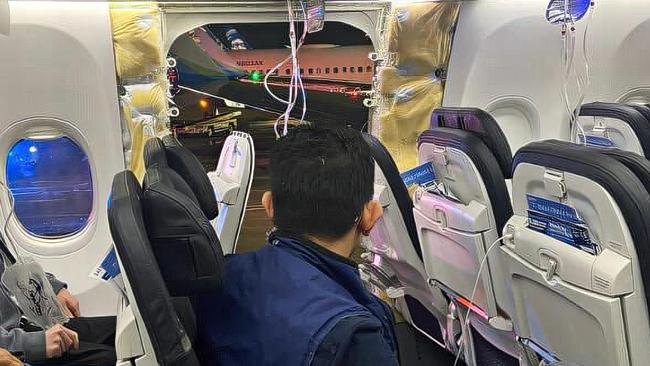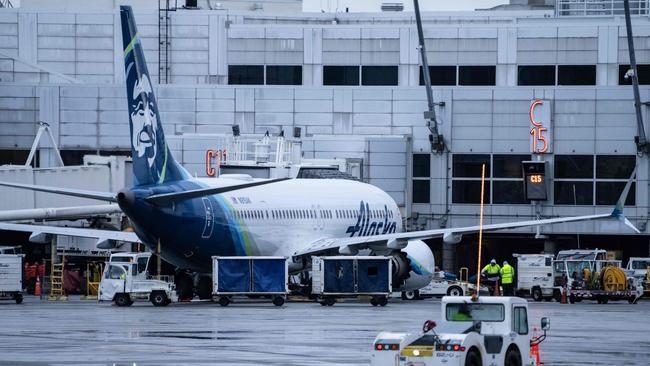US probes Alaska Airlines door panel in Boeing blowout
Federal authorities are investigating how a door plug - still missing - blew off a Boeing 737 MAX 9 plane in midair and forced an emergency landing.

A federal probe into Friday’s Alaska Airlines flight has started with a focus on the door plug -- still missing -- that violently blew off the plane in midair, leaving a gaping hole in its side.
Jennifer Homendy, chair of the National Transportation Safety Board, examined the stricken Boeing 737 MAX 9 jet after she arrived in Portland, Ore., on Saturday afternoon. She described a ghostly scene inside the cabin with seat backs missing and with clothing scattered around.
“We believe as a result of this violent, explosive action that took place and the rapid decompression, there was sort of a ripple effect throughout the plane,” she said in an interview Sunday.
The investigation is in its early stages. Technical specialists will examine everything from bolts on the door plug that ripped away to a pressurization system on the plane.
At this point, the probe is zeroed in on the Alaska Airlines accident and not on a broader set of aircraft, such as separate versions of the 737 MAX or other planes that have similar door plugs. The focus could change as evidence surfaces about why the part detached. “We don’t rule out anything at this stage,” Homendy said.
The Federal Aviation Administration ordered a temporary grounding and immediate inspections of dozens of Boeing 737 MAX 9 jets. Alaska Air and United Airlines, two of the biggest users of the jets, canceled hundreds of flights over the weekend and said they would work with the FAA to conduct the inspections.
Investigators are looking for the public’s help finding the door plug and for any video from inside the cabin. The NTSB has homed in on an area about 6 miles west of Portland’s downtown where it believes the part may have landed, citing radar data. The part, which hadn’t been found as of Sunday afternoon, would likely provide clues about what happened.
The accident could have been much worse had it happened at cruising altitude -- with passengers and crew walking around the cabin -- instead of during the plane’s ascent just about 10 minutes from the airport, Homendy said at a Saturday news conference.
“We are very, very fortunate here that this didn’t end up in something more tragic,” she said Saturday. No one was seated in the two seats next to the door plug that blew out.
The MAX 9 is a bigger version of the MAX 8 that was involved in two fatal accidents. Crashes of the smaller MAX 8 in 2018 and 2019 grounded the jets around the world for almost two years. The accidents took 346 lives and drew scrutiny from federal regulators and lawmakers.
The piece that was torn off during Friday’s flight was a panel that plugs an optional emergency exit on the MAX 9, used by airlines such as Alaska that have fewer seats and don’t need the additional exit. An identical door panel on the opposite side of the plane remained intact, Homendy said.
The plug can be opened from the outside for inspection but doesn’t operate as a door on planes like the one Alaska was flying, Homendy said. Other airlines that install extra seats on MAX 9 jets would have an actual emergency-exit door placed in that location, which is toward the rear of the plane.
Fuselage maker Spirit AeroSystems is responsible for installing the emergency door configuration involved in Friday’s incident. Spirit AeroSystems was working with Boeing to determine what went wrong.
The Alaska plane had experienced two cockpit indications of pressurization issues in the days leading up to the flight, Homendy said. Investigators have been told that the airline’s maintenance looked at the issue, but it isn’t clear if there is any link between the alerts and the incident.
The FAA directive affects about 171 of the roughly 200 MAX 9 jets in service around the world. The inspections will take between four and eight hours for each airplane, which then can return to service.
United and Alaska on Saturday had said that some of their MAX 9 jets had already undergone inspections and could continue flying. But they pulled the planes from service again later that day to await more information about additional work that may be required to comply with the FAA’s order.
Alaska, which has 65 MAX 9 planes, said it had canceled 330 flights Saturday and Sunday and expected significant impact to continue through the first half of the week. United said it canceled 270 flights over the weekend due to the grounding, but was able to swap aircraft and avoid canceling dozens of others. It has parked all 79 of its MAX 9 jets. United has started taking initial steps, removing an internal panel to gain access and starting preliminary inspection work.

The carriers said Sunday they were waiting on further instructions from the FAA and Boeing to conduct the required inspections. Some non-U.S. carriers, including Panama’s Copa Airlines and Mexico’s Aeromexico, said they were temporarily grounding their MAX 9 jets pending the necessary inspection.
A door-plug panel that blows off could injure passengers or crew, hit the plane or cause a loss of control, the FAA said in its directive. It also leaves an emergency exit-sized hole, depressurizing the plane and buffeting passengers with high-speed winds. The FAA said the potential for a similar problem “is likely to exist or develop in other products of the same type design.” Boeing, which has been dogged by quality issues, said it agrees with the FAA’s decision and that it has a technical team aiding the NTSB’s investigation. “Safety is our top priority and we deeply regret the impact this event has had on our customers and their passengers,” the company said.
The Alaska jet took off Friday evening from Portland carrying 171 passengers and six crew. It had reached an altitude of about 16,000 feet when it had to make an emergency U-turn and return to the airport.
The plane was almost brand new. It entered commercial service in November and had made fewer than 150 flights, according to Flightradar24, a flight-tracking service.
As a plane ascends, the difference between the pressure inside the cabin and outside increases. If an opening emerges during flight, air in the plane will rush out. That could send objects hurling through the cabin and potentially pull out passengers. The effect is more intense at higher altitudes.
Depressurization incidents like the Alaska flight experienced are rare, but aircraft are designed to withstand them and continue flying. Pilots are trained to move quickly to bring planes down when they happen.
WSJ



To join the conversation, please log in. Don't have an account? Register
Join the conversation, you are commenting as Logout